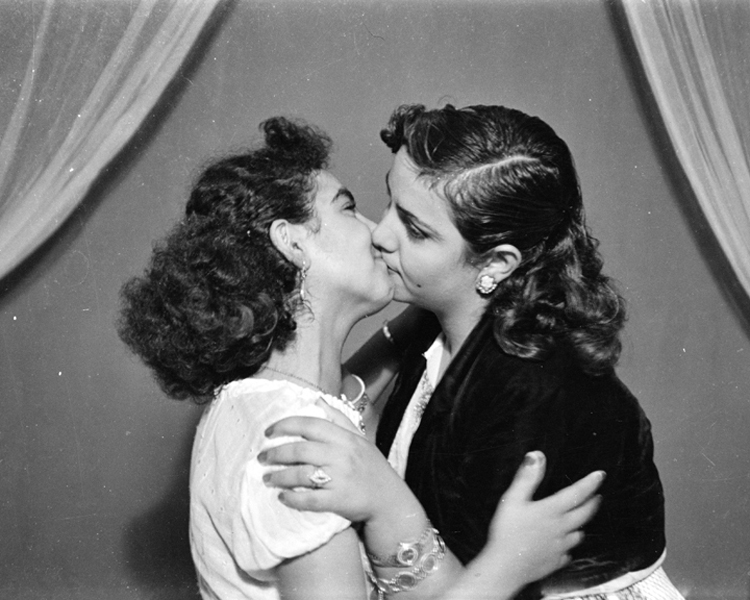
© » KADIST
Akram Zaatari
“Films inspired people a lot. they came to perform kissing in front of a camera. In a conservative society such as Saida, people were willing to play the kiss between two people of the same sex, but very rarely between a man and a woman.

© » KADIST
Douglas Gordon
Blind Spencer is part of the series “Blind Stars” including hundreds of works in which the artist cut out the eyes of Hollywood stars, in a symbolically violent manner. An emptiness (some are burned letting appear a white or mirror background or a mirror) replaces the eyes, giving the impression of a blind eye deprived of all expression. Paradoxically, the work looks at us all the more intensely.

© » KADIST
Akram Zaatari
“While taking the picture it was challenging to make the boys sit properly without moving. Sometimes a member of the family whould hide behind, holding the child.” Hashem El Madani. Hashem El Madani, a studio photographer in Saida, began working in 1948.

© » KADIST
Ranu Mukherjee
Conceived as a large-scale mural-like projection, Color of History, Sweating Rocks is a neo-futuristic, hybrid film that combines cinematic language, collage, animation, and inventive forms to highlight the plight of the peoples of the Sahara—and refugees in general—who have been displaced by oil-mining.
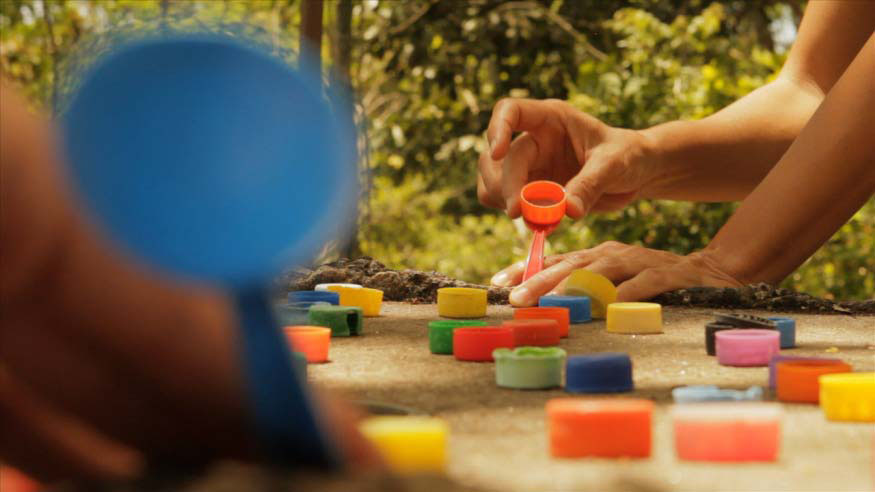
© » KADIST
Donna Conlon and Jonathan Harker
In Tapitapultas (2012), Donna Conlon and Jonathan Harker comment on mass consumerism and pollution by way of a game they invented. The artists used disposable spoons as catapults to shoot thousands of plastic bottle caps at a hole in a concrete platform. The platform was once part of a U. S. military installation in the Panama Canal Zone, and it is now an observation deck in a nature park.

© » KADIST
Akram Zaatari
“People often asked if they could pose with the Kodak advertisement where a full scale woman is featured with a camera offering Kodak rolls. They invented the poses, the gestures and situations.” Hashem El Madani. Hashem El Madani, a studio photographer in Saida, began working in 1948.

© » KADIST
Julio Cesar Morales
Drawing & Print (Drawing & Print)
Julio Cesar Morales’s watercolor drawings, Undocumented Intervention , show a variety of surprising hiding places assumed by people trying to cross into the United States without documentation. Morales drew inspiration from both his childhood near the United States-Mexico border as well as from photographic documentation on U. S. government websites.

© » KADIST
Douglas Gordon
Douglas Gordon’s single-channel video The Left Hand Can’t See That The Right Hand is Blind, captures an unfolding scene between two hands in leather gloves—at first seemingly comfortable to be entwined, and later, engaged in a struggle. As suggested by the work’s title, each of the hands assumes a character with a distinct personality, as if we were witnessing a lovers’ quarrel and embrace, or the embodiment of opposing forces of an internal struggle. Gordon has previously created performance-based works depicting his own body or parts of it—arms, hands, fingers, eyes—usually enacting simple, repetitive movements.
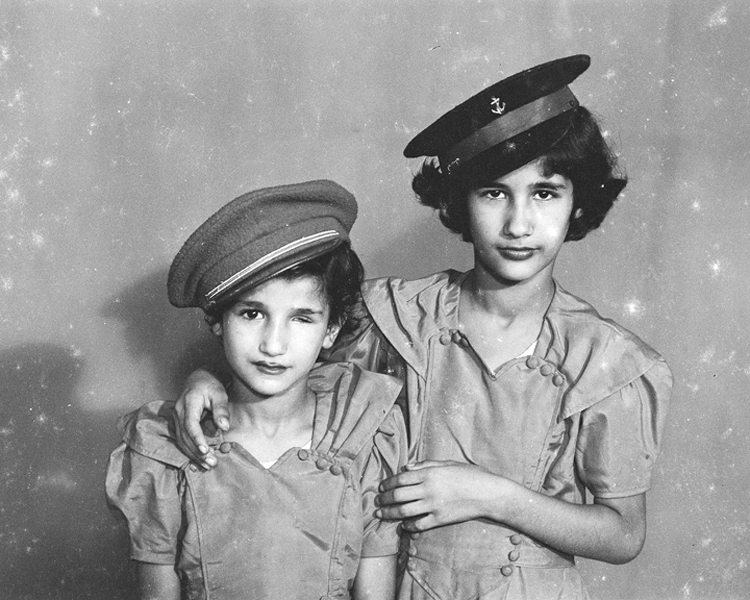
© » KADIST
Akram Zaatari
Hashem El Madani, a studio photographer in Saida, began working in 1948. Like all studio photographers his subjects came to him. The studio was a constant flux of visitors.

© » KADIST
Akram Zaatari
“People often asked if they could pose with the Kodak advertisement where a full scale woman is featured with a camera offering Kodak rolls. They invented the poses, the gestures and situations.” Hashem El Madani. Hashem El Madani, a studio photographer in Saida, began working in 1948.

© » KADIST
Xu Tan
Drawing & Print (Drawing & Print)
Shanghai Biennale, Awaiting Your Arrival is an appropriation of the posters made to promote biennial art exhibitions. Displayed alongside the marketing posters of official biennials (Shanghai, Berlin, Venice, etc.) Displayed alongside the official marketing materials of biennials (Shanghai, Berlin, Venice, etc.)

© » KADIST
Roman Ondak
This work needs to be considered in relation to one of his performances during which people were made to queue in front of the Kunsthalle of Frankfurt in 2003 (Tate Collection). In this instance Ondak collected images of people queuing in front of all sorts of buildings in various newspapers. He then inserted these in a Slovakian newspaper without trying to give any coherence with the information in the text on the same page.

© » KADIST
Akram Zaatari
“People often asked if they could pose with the Kodak advertisement where a full scale woman is featured with a camera offering Kodak rolls. They invented the poses, the gestures and situations.” Hashem El Madani. Hashem El Madani, a studio photographer in Saida, began working in 1948.

© » KADIST
Akram Zaatari
“When you position your hand on someone’s shoulder, your shoulders become straight and horizontal. Placing one’s hand on a stable surface helps position the shoulders and the general posture of the body.” Hashem El Madani. Hashem El Madani, a studio photographer in Saida, began working in 1948.

© » KADIST
Akram Zaatari
“Other photographers used to send me negatives of cross-eyed people, asking me to retouch them. I used to scratch out the emulsion where the pupil is, and draw another one right next to it.” Hashem El Madani. Hashem El Madani, a studio photographer in Saida, began working in 1948.

© » KADIST
Andrew Grassie
In 2008, Grassie was invited by the Whitechapel Gallery to document the transformation of some of its spaces. The artist chose to depict the space before and after, thus creating the series titled “After the Archive Collections Room.” This group of paintings displays a space locked into time with its scaffolding and broom exposed, depicted just before an exhibition on a collection of archives.

© » KADIST
Julio Cesar Morales
The video Interrupted Passage presents a performance Morales staged in the former home of Mariano Guadalupe Vallejo, a mid-nineteenth-century Mexican general serving in California. Reenacted here is Vallejo’s acquiescence to Americans who were attempting to overthrow Mexican governance of the region. When a small militia arrived at Vallejo’s house to arrest him, he invited them in and shared a meal.

© » KADIST
Artur Zmijewski
Zeppelintribüne (2002) was shot near the Zepelintribune in Nuremberg, designed by Albert Speer, chief architect of the Third Reich. The 360-metre-long structure is part of a larger architectural complex called the Zeppelinfeld, which the National Socialist used for their marches and rallies. The Zeppelintribune was immortalized in the Leni Reifenstahl’s film-propaganda masterpiece the Triumph of the Will, a record of a 1934 Nazi Party rally.
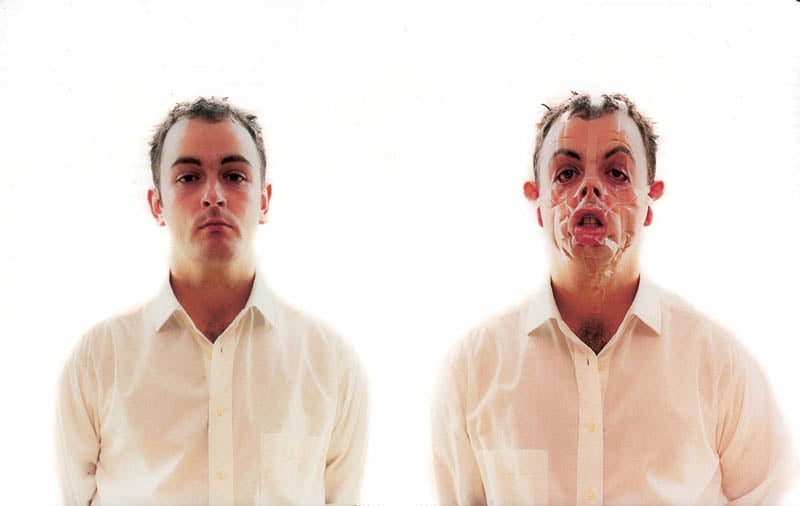
© » KADIST
Douglas Gordon
In Monster (1996-97), the artist’s face becomes grotesque through the application of strips of transparent adhesive tape, typical of Gordon’s performance-based films that often depict his own body in action. Also characteristic of his work, the scene takes place in front of a mirror, suggesting the kind of personal self-reflection that one is capable of – both good and evil. The video makes clear cinematographic reference to the ‘alter-ego’ transformation in Mamoulian’s Dr. Jekyll and Mr. Hyde, and to the “You looking at me?” sequence performed in front of a mirror by Robert De Niro in Scorsese’s Taxi Driver which also inspired Gordon’s through a looking glass ( 1999).

© » KADIST
Roman Ondak
Drawing & Print (Drawing & Print)
As the caption purposely admits, these drawings were made by friends of Ondák’s at home in Slovakia asked to interpret places he has journeyed to. The description of the blond artist wearing the same outfit and bag in places of transit like airports, stations or streets are faithful in straightforward (verging on naïve) styles. His own skill as artist is displaced and delegated to others with no particular gift in draftsmanship.

© » KADIST
Akram Zaatari
“These are negatives that were scratched because of a jealous husband from the Baqari family, who never let his wife out by herself. He was upset to know that she came to be photographed in my studio without telling him. He came asking for the negatives.
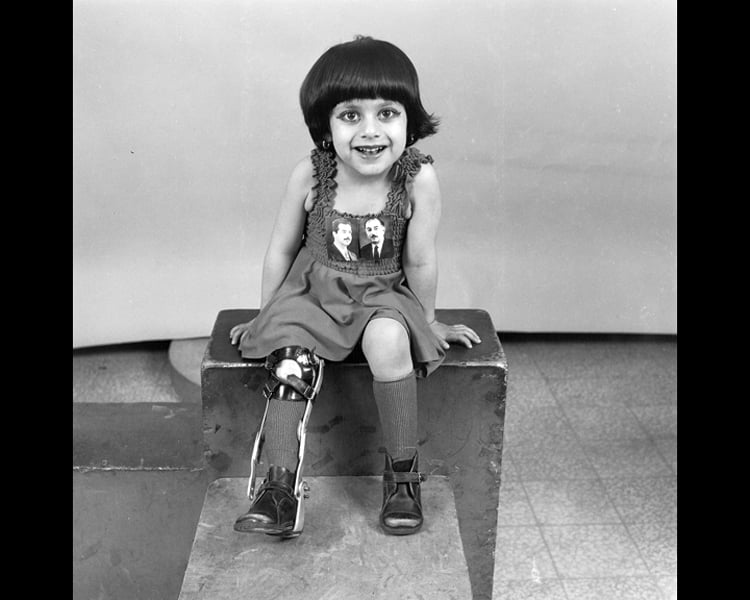
© » KADIST
Akram Zaatari
“In the 1980s I started using coloured paper backdrops, one of which was yellow. You can see they never reached the floor. I used them for colour and black-and-white photography.” Hashem El Madani.

© » KADIST
Barry McGee
Barry McGee’s Untitled is a collection of roughly fifty, framed photographs, paintings, and text pieces clustered together in corner. Its tiled effect can perhaps be seen as a vertical Carl Andre work and also bears some resemblance to another work in the Kadist Collection, Jedediah Caesar’s JCA-25-SC. McGee’s installation also echoes the votive altars in the chapels he visited during his residency in Brazil in 1993.
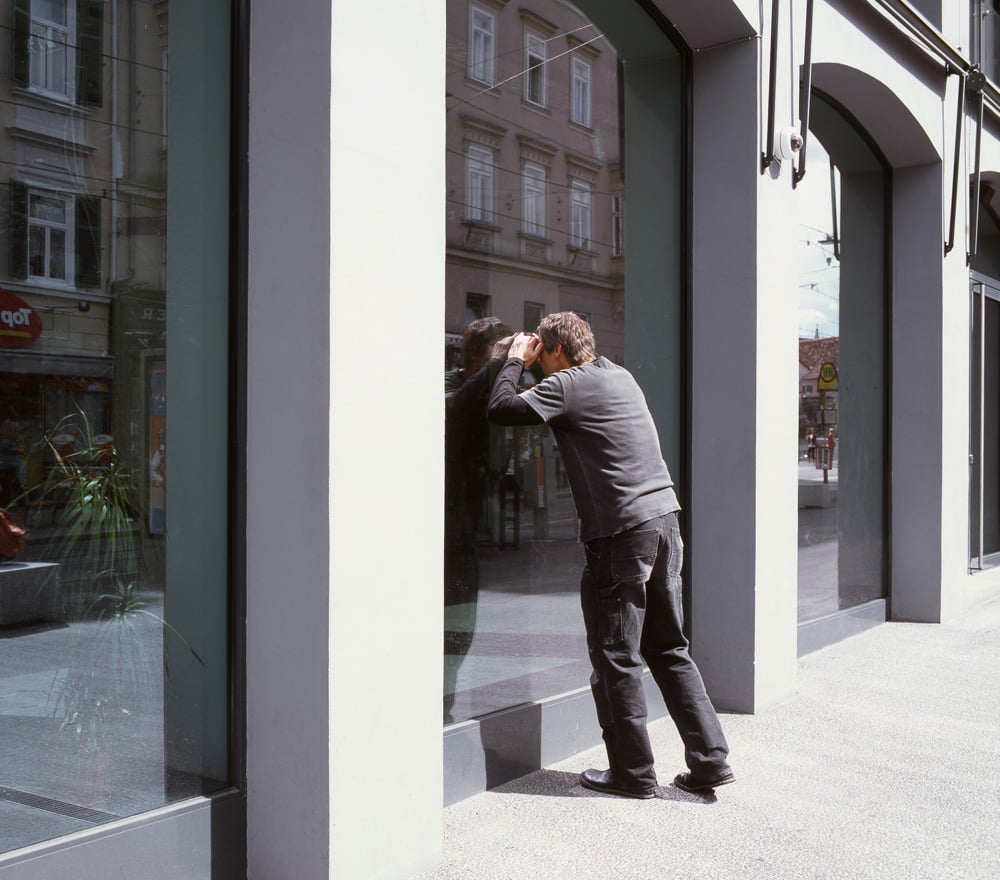
© » KADIST
Roman Ondak
“A man wanders near the windows of a gallery, situated adjacent to the street. He occasionally gazes through windows into the gallery but never enters.” Passersby are numerous since these windows are by a tram stop on a busy street. It is surprising to note how few of them take any notice of this man peering repeatedly through the slightly tinted glass into an empty meeting room with no distinctive signs to be seen.

© » KADIST
Xu Tan
Drawing & Print (Drawing & Print)
Biennale, Dog is an appropriation of the posters made to promote biennial art exhibitions. Displayed alongside the official marketing materials of biennials (Shanghai, Berlin, Venice, etc.) Xu’s works provide a satiric and provocative alternative to the official system and make publicly visible images of many realities.

© » KADIST
Akram Zaatari
“The two men were relatives and both were in the Lebanese Army.” Hashem El Madani. Hashem El Madani, a studio photographer in Saida, began working in 1948. Like all studio photographers his subjects came to him.

© » KADIST
Julio Cesar Morales
Contrabando is a work that references the larger sociological phenomenon in which immigrant economic strategies come to infiltrate urban landscapes. It is a study of the realities and consequences of exploited labor that simultaneously aims to record the living history of labor.
Akram Zaatari
- location: Sayda, Al-Lubnan
- year born: 1966
- gender: male
- nationality: Lebanese
Julio Cesar Morales
- location: San Francisco, California
- year born: 1966
- gender: male
- nationality: Mexican
- home town: Tijuana, Mexico
Douglas Gordon
- location: Berlin, Germany
- year born: 1966
- gender: male
- nationality: Scottish
- home town: Glasgow, United Kingdom
Roman Ondak
- location: Zilina, Slovenská Republika
- year born: 1966
- gender: male
- nationality: Slovakian
Xu Tan
- location: Amsterdam, Netherlands
- year born: 1966
- gender: female
- nationality: Dutch
- home town: Pekan Baru, Indonesia
Barry McGee
- location: San Francisco, California
- year born: 1966
- gender: male
- nationality: American
- home town: San Francisco, California
Artur Zmijewski
- location: Warszawa, Polska
- year born: 1966
- gender: male
- nationality: Polish
Ranu Mukherjee
- location: San Francisco, California
- year born: 1966
- gender: female
- nationality: Indian
Donna Conlon and Jonathan Harker
- location: Panama City, Panama
- year born: 1966
- nationality: American and Ecuadorian
Jeremy Deller
- location: London, United Kingdom
- year born: 1966
- gender: male
- nationality: British
Andrew Grassie
- location: Edinburgh, United Kingdom
- year born: 1966
- gender: male
- nationality: British
-
1950-1959
Akram Zaatari
1950“While taking the picture it was challenging to make the boys sit properly without moving...
Akram Zaatari
1950“Other photographers used to send me negatives of cross-eyed people, asking me to retouch them...
Akram Zaatari
1950“In the 1980s I started using coloured paper backdrops, one of which was yellow...
Akram Zaatari
1956“People often asked if they could pose with the Kodak advertisement where a full scale woman is featured with a camera offering Kodak rolls...
Akram Zaatari
1957“These are negatives that were scratched because of a jealous husband from the Baqari family, who never let his wife out by herself...
-
1960-1969
Akram Zaatari
1960“When you position your hand on someone’s shoulder, your shoulders become straight and horizontal...
Akram Zaatari
1966“People often asked if they could pose with the Kodak advertisement where a full scale woman is featured with a camera offering Kodak rolls...
-
1970-1979
Akram Zaatari
1970“People often asked if they could pose with the Kodak advertisement where a full scale woman is featured with a camera offering Kodak rolls...
Akram Zaatari
1972“The two men were relatives and both were in the Lebanese Army.” Hashem El Madani...
-
1990-1999
Douglas Gordon
1996In Monster (1996-97), the artist’s face becomes grotesque through the application of strips of transparent adhesive tape, typical of Gordon’s performance-based films that often depict his own body in action...
-
2000-2009
Xu Tan
Drawing & Print
2000(Drawing & Print) Shanghai Biennale, Awaiting Your Arrival is an appropriation of the posters made to promote biennial art exhibitions...
Douglas Gordon
2002Blind Spencer is part of the series “Blind Stars” including hundreds of works in which the artist cut out the eyes of Hollywood stars, in a symbolically violent manner...
Artur Zmijewski
2002Zeppelintribüne (2002) was shot near the Zepelintribune in Nuremberg, designed by Albert Speer, chief architect of the Third Reich...
Roman Ondak
2003This work needs to be considered in relation to one of his performances during which people were made to queue in front of the Kunsthalle of Frankfurt in 2003 (Tate Collection)...
Roman Ondak
Drawing & Print
2003(Drawing & Print) As the caption purposely admits, these drawings were made by friends of Ondák’s at home in Slovakia asked to interpret places he has journeyed to...
Xu Tan
Drawing & Print
2003(Drawing & Print) Biennale, Dog is an appropriation of the posters made to promote biennial art exhibitions...
Douglas Gordon
2004Douglas Gordon’s single-channel video The Left Hand Can’t See That The Right Hand is Blind, captures an unfolding scene between two hands in leather gloves—at first seemingly comfortable to be entwined, and later, engaged in a struggle...
Julio Cesar Morales
Drawing & Print
2006(Drawing & Print) Julio Cesar Morales’s watercolor drawings, Undocumented Intervention , show a variety of surprising hiding places assumed by people trying to cross into the United States without documentation...
Julio Cesar Morales
2008The video Interrupted Passage presents a performance Morales staged in the former home of Mariano Guadalupe Vallejo, a mid-nineteenth-century Mexican general serving in California...
Andrew Grassie
2009In 2008, Grassie was invited by the Whitechapel Gallery to document the transformation of some of its spaces...
-
2010-2019
Ranu Mukherjee
2011Conceived as a large-scale mural-like projection, Color of History, Sweating Rocks is a neo-futuristic, hybrid film that combines cinematic language, collage, animation, and inventive forms to highlight the plight of the peoples of the Sahara—and refugees in general—who have been displaced by oil-mining....
Julio Cesar Morales
2011Contrabando is a work that references the larger sociological phenomenon in which immigrant economic strategies come to infiltrate urban landscapes...
Donna Conlon and Jonathan Harker
2012In Tapitapultas (2012), Donna Conlon and Jonathan Harker comment on mass consumerism and pollution by way of a game they invented...
Jeremy Deller
2012Beyond the White Walls , with a commentary written and spoken by Jeremy Deller, is often wryly amusing...



